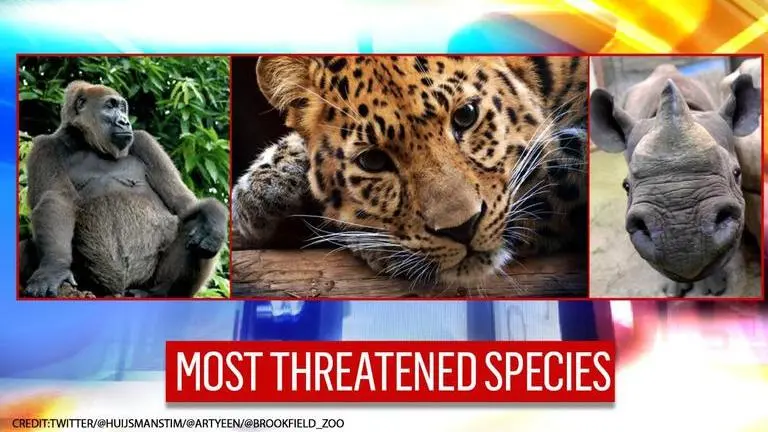Updated 3 March 2021 at 19:39 IST
World Wildlife Day 2021: Five critically endangered species on UN red list
Declined over 80 percent in its population over approximately 21 years, species of white antelope has dipped to 300 in the Tin Toumma region of Niger.
- World News
- 4 min read

On March 3, nations celebrate World Wildlife Day to commemorate the signature of the Convention on International Trade in Endangered Species of Wild Fauna and Flora (CITES) that seeks to protect the world’s wild animals and plants. This year, the theme for the special day was Forests and Livelihoods: Sustaining People and Planet. While this day highlights the central role of forests, forest species, and our ecosystem which is integral in sustaining the livelihoods of hundreds of millions of people, let's take a look at the critically endangered forest species that have been on UN’s red list with the highest risk of extinction. Below are some of the animals which are subjected to life-threatening human-enabled practices such as illegal poaching, habitat destruction, and the effects of climate change, due to which their overall population has drastically reduced pushing them to the brink of extinction.
1. Saharan bovid speciesc
Declined over 80 percent in its population over the past three-generation, approximately 21 years, this species of white antelope and the screw horn antelope has reached just a few 300 located in the Tin Toumma region of Niger. Subjected to threats of hunting and habitat loss, the Addax, which inhabits the deserts of Northern Africa throughout most of the Sahara is reaching near extinction largely due to illegal hunting for its striking long spiral horn. Its coat reflects the lightest-colored texture in summer and smoky gray in winter and is known for endurance over speed which makes the species prone to attacks by hunters. While other antelopes of North Africa—gazelles and the related scimitar-horned oryx are still found in abundance, slender-horned Addax’s sightings are by far a few and have been put on the International Union for Conservation of Nature and Natural Resources (IUCN) in 2020.
This crew really resonates to the dinner bell. #addax #antelope #criticallyendangered #sahara #africa #texas #faith #faithinnature pic.twitter.com/y8QEeRNxmz
— Dan Cabela (@discodantheman) July 29, 2020
2. Amur Leopard
The critically endangered Amur leopards are found just about more than 84 in number in the savannas of Africa. Some in the Russian Far East have adapted to temperate forests that make up the northern-most part of the species’ range. These incredibly fast species that can run 37 miles per hour are similar to other leopards but are rare due to their gigantic size, 19 feet horizontally and 10 feet vertically. With a life span of 10-15 years, the Amur leopard also known as the Far East leopard, the Manchurian leopard, or the Korean leopard is critically endangered.
[Credit: Twitter/@rosemallows__]
Advertisement
Advertisement
3. Black Rhino
Black rhinos, the smallest of the two popular African rhino species due to their hooked upper lip are the endangered species found in Africa. Their population has reduced to a sobering 98 percent to less than 2,500 and the animal has been pushed to the brink of extinction. These rhinos are subjected to poaching and black-market trafficking for their unique two horns, and occasionally a third, small posterior horn. Their recovery has been extremely difficult but the persistent conservation efforts has doubled their population from historic low approximately 20 years ago to at least 5,600 today.
After a day of exploring, orphaned black rhino Apollo beds down in his custom-built stable. Freshly-cut greens adorn the walls so he never goes hungry during the night. Your support provides Keeper care, milk and a protective environment for him #thankyou pic.twitter.com/QrWUS57lFs
— Sheldrick Wildlife (@SheldrickTrust) February 27, 2021
4. Cross River Gorilla
This subspecies of the western gorilla, which is very similar in appearance to the western lowland gorilla, has been pushed to extinction due to the human encroachment on the gorilla’s territory—clearing forests for timber and creating fields for agriculture and livestock. "Poaching occurs in the forests as well, and the loss of even a few of these gorillas has a detrimental effect on such a small population,” UN’s wildlife organization revealed in a statement. WWF and partners are working with the governments of Cameroon and Nigeria to conserve the population and create Cross River gorilla protected habitats.
[Credit: UN/WWF]
5. Asian Elephant
The largest land mammal on the Asian continent, the Asian elephant is found in groups of six to seven related females that are led by the oldest female in dry to wet forest and grassland habitats. These endangered species have habitats across South and Southeast Asia. While the elephants survive on forage plants for food, the encroachment in their area has reduced the food options and two-thirds of an elephant's day may be feeding on grasses. With a population decline of more than 50 percent, the Asian elephant has been listed as Endangered on the IUCN Red List. These animals are often hunted for tusks and are routinely subjected to habitat degradation, fragmentation, and poaching.
[Credit: UN/WWF]
Published By : Zaini Majeed
Published On: 3 March 2021 at 19:42 IST



